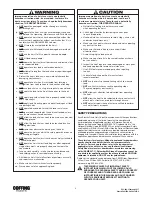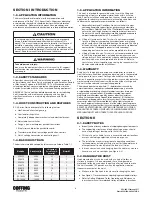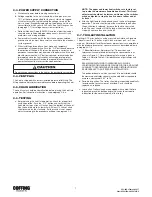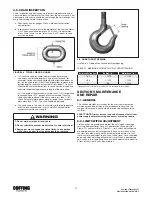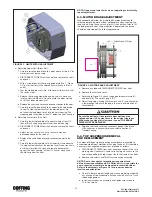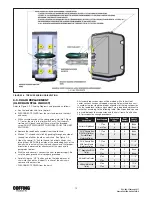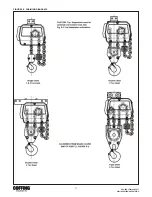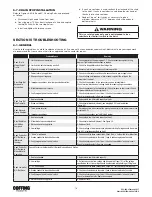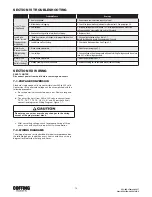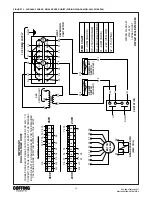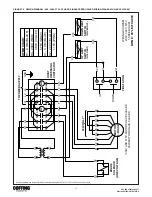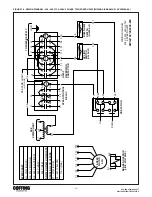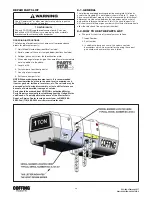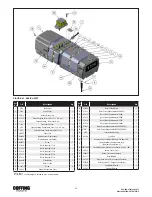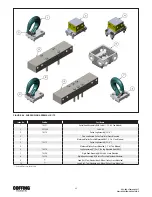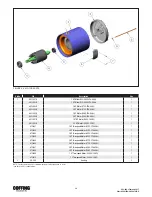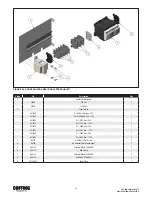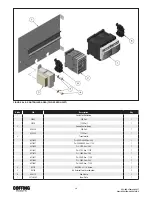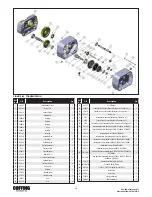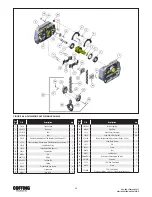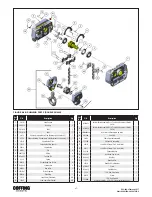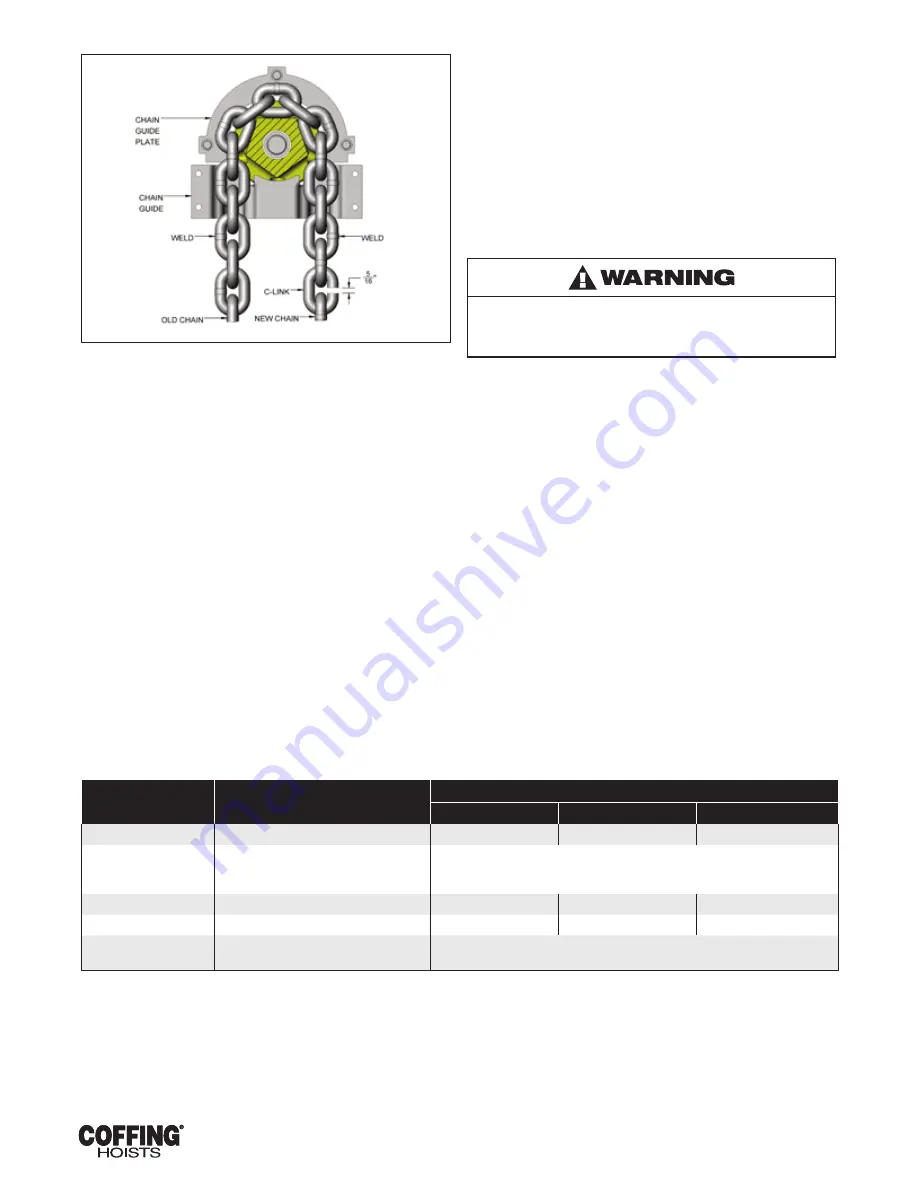
16
EC3-680-3 February 2017
Order # 5041558-0 & 5041679-0
FIGURE 5-4. CHAINING HOIST
j. Remove both the "C" link and the old chain from the slack
end pin (No. 13, Figure 8-6). This can be accomplished by
depressing the pin against the slack end spring (14) with a
small screwdriver. Depress the slack end pin and install the new
chain observing proper orientation of the slack end of the chain
when secured. .Avoid twists in the chain.
k. Adjust the lower limit switch per paragraph 5-2.b.
l. Attach the bottom hook on single-chained hoists to the loose
end of the chain. On double-chained hoists, feed the loose end
of the chain through the load block (welds of the upstanding
links will be in towards the sheave) and fasten the end of the
chain to the dead end pin (No. 31, Figure 8-6B). On triple chain
hoists, feed the loose end of the chain through the load block
(welds toward sheave), around the idler sheave in the hoist, and
to the center of the load block.
m. Adjust the upper limit switch per paragraph 5-2.a (No. 30,
Figure 8-6C)
n. Lubricate the new chain per paragraph 5-6.a and perform an
operation test of the hoist.
5-6. LUBRICATION
Proper lubrication is necessary for long, trouble-free hoist operation.
Refer to the following and to Table 5-1, Recommended Lubrication
Schedule, for lubrication points, type of lubricant, and frequency of
lubrication.
a. Load Chain. Clean the load chain with a non-acid and non
caustic solvent and coat with SAE 90 gear oil. Wipe excess
oil to prevent dripping. If the hoist is used in an atmosphere
containing abrasive dust, the chain should be cleaned and oiled
more frequently. Never apply grease to the chain.
b. Gearing. The gear case of the hoist is filled at assembly with
1 gal. of a gear oil containing special friction-reducing additives.
The use of gear oils other than that recommended in Table
5-1 can cause brake chatter or can render the load brake
incapable of holding a load. A 1 gal. container of this oil is
available from Coffing (Part No. 14J11).
c. To check the oil level, remove the 1/4" pipe plug from the
side of the hoist. With the hoist hanging level, transmission oil
should be even with the edge of the tapped plug hole.
d. The length of time between necessary oil changes will depend
on the severity of use the hoist receives. In general, the oil
should be changed every 12 months of normal operation, or
every 200 hours of actual hoist on-time. Very heavy use or
operation in high ambient temperatures (over 105°F) will require
that oil be changed more often. An indication of the need for oil
replacement is load brake noise. If an erratic tapping sound is
made when lowering a load, the oil should be changed.
e. Limit Switch Shaft. To prevent rust, the threaded limit switch
shaft should be given a light coat of grease or sprayed with a
general purpose lubricant.
f. Idler Sheave Bearing (double and triple chain models only).
Use a grease gun to put about a teaspoon of grease through
the grease fining in the bottom block shaft. Avoid pumping an
excessive amount of grease into the bottom block. On triple
chain hoists, use a grease gun to lubricate the idler sheave in
the hoist until fresh grease pumps from the ends of the sheave.
g. Hook Bearing. Apply a few drops of SAE 30 oil around the edge
of the bearing.
TABLE 5-1. RECOMMENDED LUBRICATION SCHEDULE MODEL EC ELECTRIC CHAIN HOIST
Component
Type of Lubricant
Type of Service and Frequency of Lubrication
Heavy
Normal
Infrequent
Load Chain
SAE 90 Gear Oil
Daily
Weekly
Monthly
Gearing
Coffing No. H-7813 transmission oil ( Kit No.
14J11 contains quantity of oil sufficient for one
oil change)
At periodic inspection (See Figure 4-1, paragraph 5-6-B)
Limit Switch Shaft
“WD-40” or general purpose spray lubricant
Monthly
Yearly
Yearly
Load Hook Bearing
SAE 30 Gear or Motor Oil
Weekly
Monthly
Yearly
Idler Sheave Bearing
(Bushing)
NLGI #2 multi-purpose lithium base grease
(Coffing No. H-7610)
At periodic inspection (See Figure 4-1)
NOTE: All bearings except hook and idler sheave bearings are prelubricated and sealed.
* This lubrication schedule is based on a hoist operating in normal environmental conditions. Hoists operating in adverse atmospheres containing excessive heat, corrosive fumes or vapors,
abrasive dust, etc., should he lubricated more frequently.


